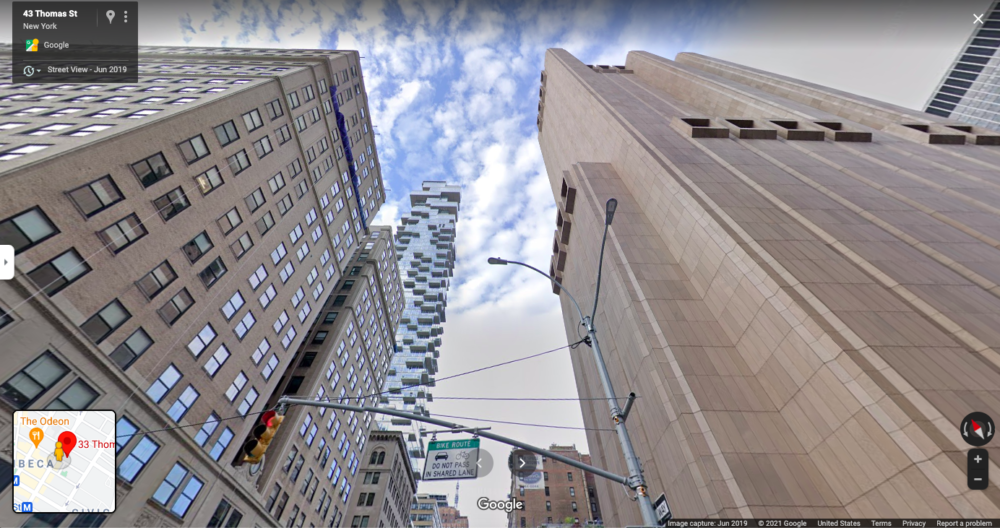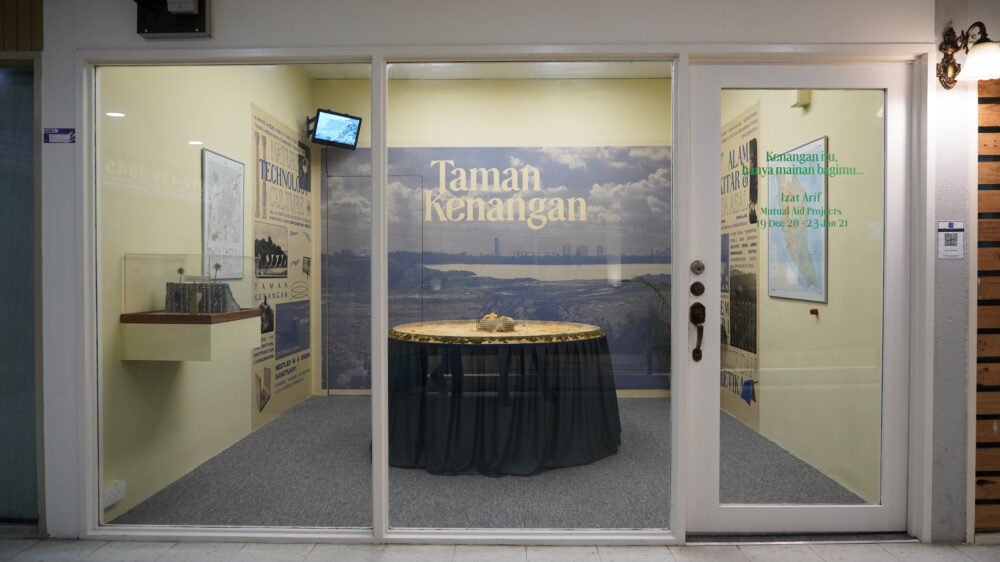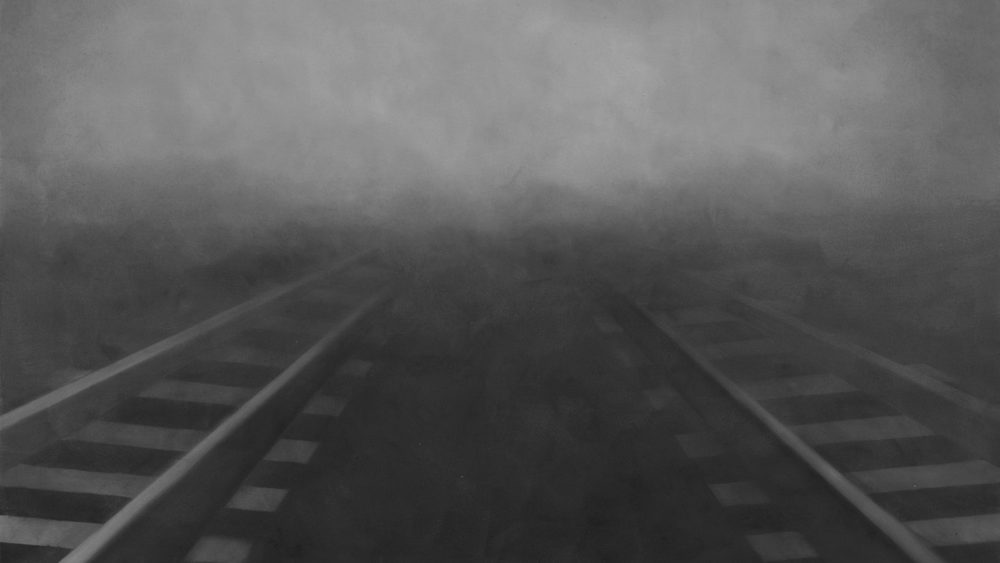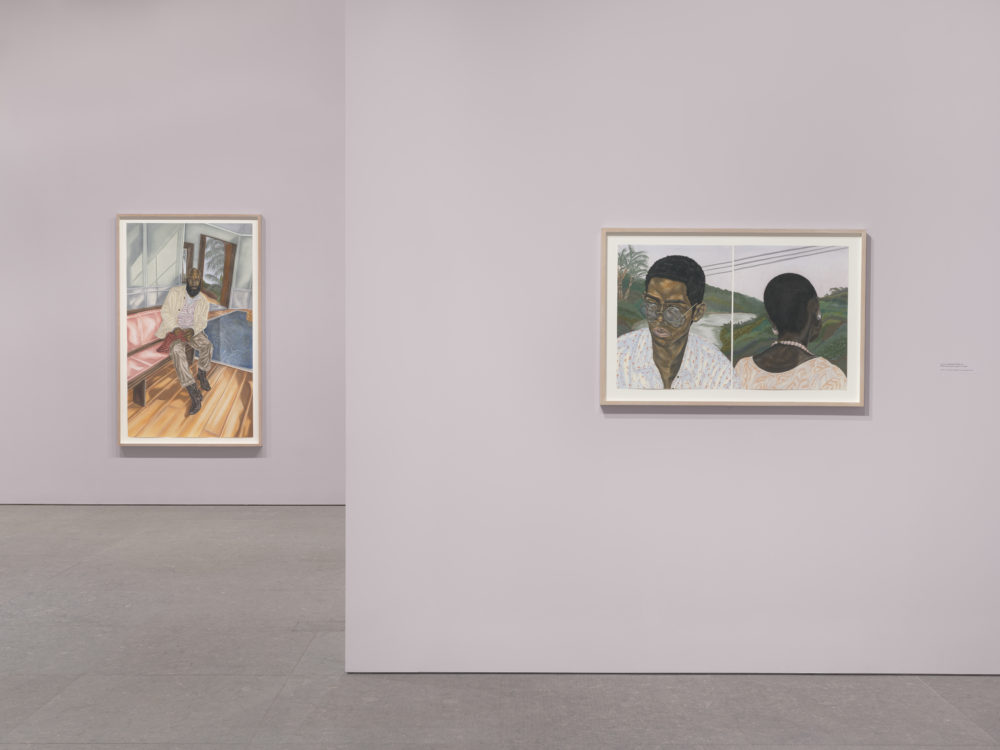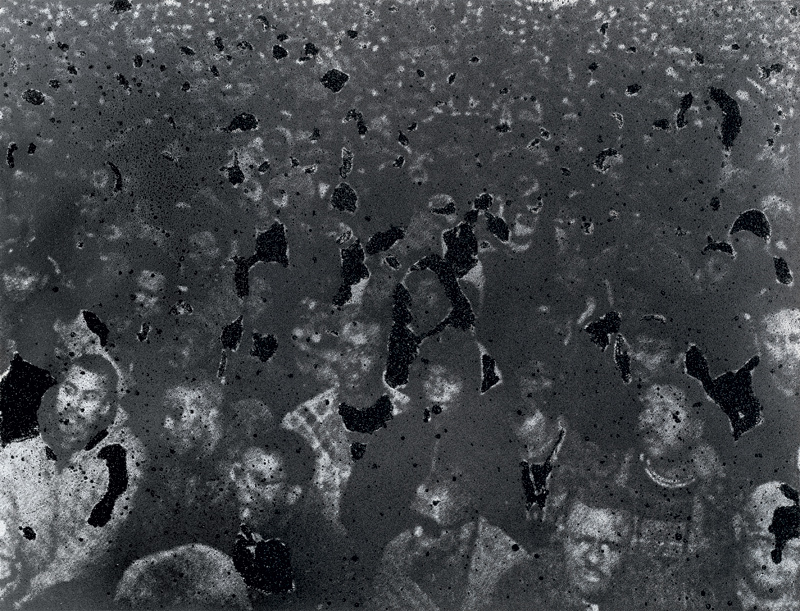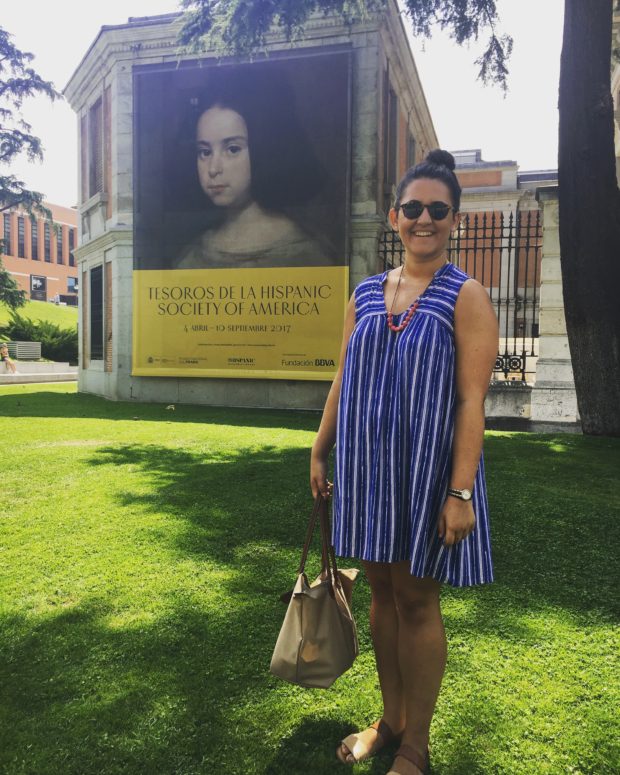This interview was conducted on December 9th, 2021 as part of New York University’s Curatorial Collaborative. This initiative matches BFA students from NYU Steinhardt with… Continue Reading “The Universal in the Personal:” A Conversation with David Ma and Caleb Williams
Posts tagged as “current students”
Cover image: 33 Thomas from the intersection of Church and Worth. Image courtesy of Google Maps. A few blocks south of Canal Street in Tribeca,… Continue Reading Art and Surveillance: Hiding in Plain Sight
Eric Goh discusses how the pandemic motivated him to take a year off from his studies and start Mutual Aid Projects, a curator-run project space in Kuala Lampur. Continue Reading Eric Goh on Mutual Aid and Friendship as a Pathway Out of Disaster
“The horror of looking is not necessarily in the image but in the story we provide to fill in what is left out of the image.” -Marianne Hirsch [1]
A recent survey conducted in February 2018 by the Conference on Jewish Material Claims Against Germany found that 49% of Millennials cannot name a single concentration camp or ghetto among the dozens that operated during the Holocaust.[2] Just one month after the survey’s results became public, an exhibition of California-based artist Natalie Arnoldi titled This Happened Here opened at Charlotte Jackson Fine Art. Five large-scale paintings by Arnoldi, which were not for sale, went on view from March 9th – 31st at the gallery in the trendy Railyard District of Santa Fe, New Mexico. These five paintings offer one avenue through which contemporary art can minimize the distance between a contemporary public and a historical event like the Holocaust.
An obscure, grainy oil painting of railroad tracks descending into the bleak distance rendered in greys, whites, and blacks titled Helix (2012) functioned as the meaningful starting point of the exhibition. A few years ago, a woman visited the studio of artist Charles Arnoldi, Arnoldi’s father, where one of his daughter’s train track paintings was hanging. Upon viewing Arnoldi’s painting, the woman burst into tears. She explained that her grandmother was a survivor of Auschwitz-Birkenau and that the work had reminded her of her grandmother’s arrival to the camp. Her reaction is a potent reminder that art does not exist in a vacuum. It is also a profoundly interesting example of the power of post-memory.
In early November, IFA MA student Cindy Qi interviewed Hu Xiangqian, whose work is currently exhibited at the Institute of Fine Arts, NYU as a part of the fall Duke House Exhibition chin(a)frica: an interface, on view through February 18, 2018. Hu Xiangqian (b. 1983) was born in Leizhou, Guangdong Province and graduated in 2007 from Guangzhou Academy of Fine Arts. He currently lives and works in New York City. Hu’s artistic practice is grounded in performance and video works featuring an intentional amateurishness and crudeness. Notable exhibitions include the Gwangju Biennial (2014) and the Shanghai Biennial (2016). A photographic still of his durational performance piece entitled The Sun (2008) hangs in the Institute’s Lecture Hall. The interview was conducted in mandarin Chinese and later translated to English by Cindy Qi.
CQ: Having been in New York for several months now, do you have any discoveries or inspirations you would like to share? Have you decided what kind of work to make during your time here?
来到纽约这几个月你有什么启发或者发现呢?现在有没有构想出想做的作品呢?
HXQ: Yes, I have been preparing to get started in my studio. I live in Brooklyn and in my opinion, it’s a very isolated area that has nothing to do with art, but I like that place. It allows me to distance myself from all that is happening in Manhattan while also having the opportunity to be close to all of it. I really like this feeling of being able to pull away and engage at the same time.
我在我的工作室里准备啊,我现在住的地方比较远,在布鲁克林。 那个地方算是很荒凉的,跟艺术没有什么关系。但是我喜欢那个地方,所以我会在那里做作品。我还挺喜欢这种跟曼哈顿若即若离的感觉。
When visitors step into the Whitney’s first-floor gallery, which currently houses Toyin Ojih Odutola: To Wander Determined, they risk forgetting that they are standing in a museum. There is a softness to the space that distances it from the rest of the building, its warm lighting and the pink color of the walls evoking a feeling of intimacy that is both inviting and disorienting. A proclamation near the entrance, signed by artist Toyin Ojih Odutola in her role as “Deputy Private Secretary,” alerts viewers that the sixteen arresting works spread throughout the gallery are from the private collections of two aristocratic Nigerian families, the UmuEze Amara and Obafemi, connected through the marriage of the Marquess of UmuEze Amara, TMH Jideofor Emeka, and his husband, Lord Temitope Omodele. With this information, the intimate atmosphere is given context: it feels as if visitors have been transported to a private, family portrait gallery.
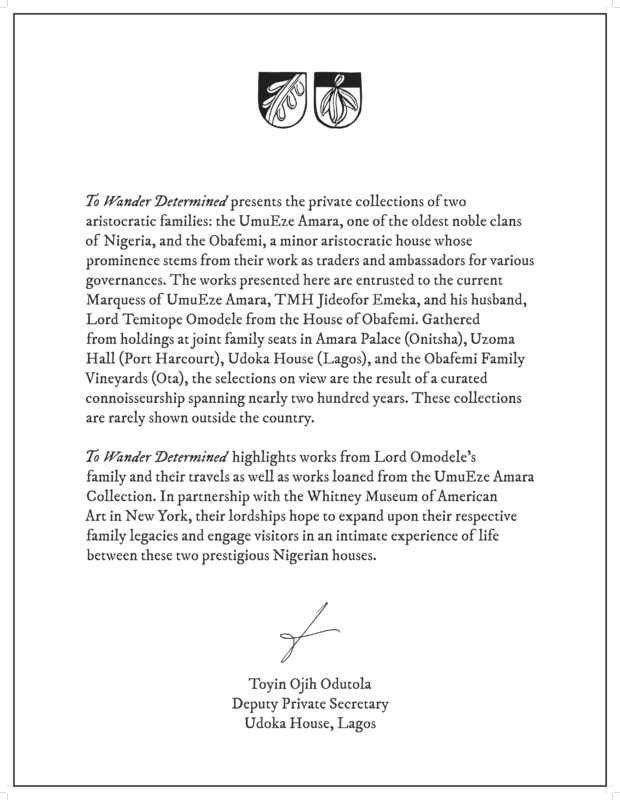
If not for the aforementioned, rather official wall text bearing the families’ crests, viewers would not know that Ojih Odutola’s subjects were of such prestigious social standing. Even armed with this knowledge, they are confronted with an incomplete narrative, left to question the identities of the elaborately fashioned figures in each portrait. No names are provided, nor are there any indications of the lineage from which each subject descends. What remains in their absence is a vague understanding that the subjects are related, as well as a desire to know how. Perhaps in other circumstances it would not occur to visitors to scrutinize the figures presented to them, but the context both provided and omitted by the artist’s proclamation incites a curiosity that may never fully be satisfied. This is the challenge that Ojih Odutola sets forth for her audience.
The Usable Past: “The concept that a self-conscious examination of historical figures, moments, and symbols can shape current and future political formation.”[1]
This is how the Whitney defines the title of one of five galleries in their ongoing permanent collection exhibition An Incomplete History of Protest. The works in the gallery present memory and nostalgia as both powerful and yet often insufficient vehicles to re-experience the past. Sharing tropes of obfuscation and anonymity, the works materialize the incomplete nature of memory and documentation.
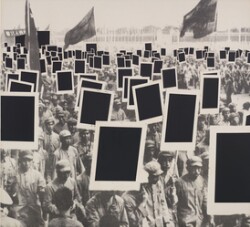
Annette Lemieux’s painting Black Mass (1991), in which she replaces the protest signs in a civil rights march with black, empty squares, hangs across the room from Glenn Ligon’s Untitled (Speech/Crowd) #2, a photograph of the Million Man March which Ligon has blurred and layered with coal dust. These works recall acts of censorship and evoke the fading hope of social change in a world where battles for civil rights must be repeatedly fought. However, the works in the exhibition that truly express the concept of “the usable past” are those which feature the museum as their main subject.
Lining the walls of the museum’s new Meatpacking building, a multiplicity of letters of protest written to the Whitney by artists and organizations related to the institution emerge from the Whitney’s archives. In a letter from 1971 addressed to former director John I.H. Baur, the Black Emergency Cultural Coalition announced their opposition to the 1971 exhibition Black Artists in America and declared their plans to demonstrate on the museum’s premises. Their initial discontent stemmed from the Whitney’s seemingly empty promise to hire and consult with black art leaders for the curating of the show. The BECC’s correspondence with the Whitney attests to the fact that the institution has dealt with issues surrounding the cultural agency of marginalized groups in an art context. Alongside this letter, dozens of other requests from artists implore the museum to remove their work as acts of protest or solidarity during moments of political unrest, and urge the museum to take a stance on current socio-political debates.
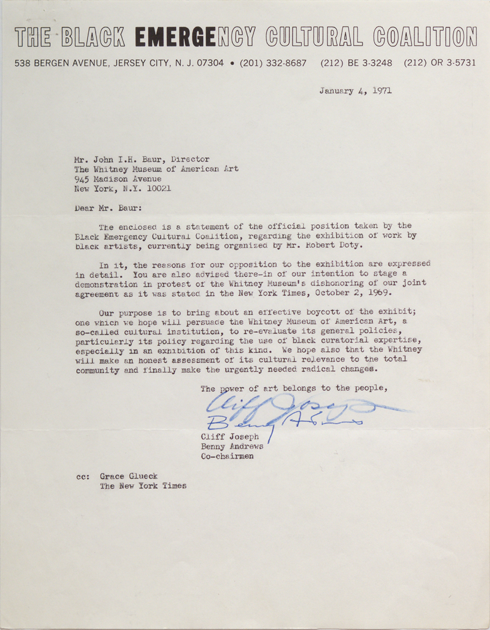
After drawing immense summer crowds, the most recent traveling exhibition at the Museo Nacional del Prado in Madrid, Tesoros from the Hispanic Society of America, Visions of the Hispanic World, closed its doors. The show truly was a museum within a museum – a mise en abîme of the New York City-based Hispanic Society of America within the galleries of the Spanish Royal Collection. The Hispanic Society normally finds its home on the Audubon Terrace at the northwest corner of 155th Street and Broadway, but after the museum closed in January to undergo significant renovations, its jewels were packed and shipped for the journey to Spain, and from there around the world. For some of these objects this was a return visit, a long-awaited homecoming after nearly a century of American residence. For many others, the Tesoros show constituted their maiden voyage to the Iberian Peninsula. During my visit in August, the vibrant and nuanced nature of this exhibition presented many topics worthy of reflection.
The Hispanic Society is the pipe dream of Archer Milton Huntington – a man who loved art, who adored museums, and whose heart, much like mine, rested somewhere between Spain and New York. Furthermore, it was crafted by Mr. Huntington: he did not merely open his wallet to finance the collection, he also played an active role in the construction of his museum and the selection of the art that would fill it. The evolution of his collection has been dependent on his legacy and the explicit wishes that he expressed through his interpersonal communication and diary entries during his lifetime.
Rather than treasuring only a few masterpieces, Huntington spent his fortune assembling a diverse variety of objects ranging across periods and media – paintings, sculptures, ceramics, glassware, prints, drawings, and more. His aims are best expressed by Mr. Huntington himself, in a claim made in his diaries that was rewritten on the wall of the third floor gallery of the Jeronimos building of the Prado show:
The museum… it must condense the soul of Spain into meanings, through works of the hand and spirit… I am collecting with a purpose and you know that purpose quite well… I wish to know Spain as Spain and so express her – in a museum. It is about all I can do. If I can make a poem of a museum it will be easy to read.
The exhibition at the Prado beautifully translates that very poem Mr. Huntington aspired to create. A walk through the galleries encourages visitors to see, to look, to wonder alongside Huntington.
Right now the CAC blog is undergoing some exciting transitions, which we hope to share with you in 1-2 months. Keep us on your radar,… Continue Reading Watch this space!

Ken Johnson’s controversial review of Now Dig This! Art and Black Los Angeles 1960-1980, currently on view at MoMA PS1 through March 11, has become nothing less than an art world scandal, sparking a deluge of denouncements from readers, an open-letter and petition against the New York Times backed by prominent artists, critics and art historians, and even an attempted rebuttal on the art critic’s Facebook page, with continued debate in the comments section. Some of Johnson’s most problematic assertions focus on questions of originality and “quality,” each clearly sited in the historical standards of high Modernism. “Black artists did not invent assemblage,” he protests. “In its modern form it was developed by white artists like Picasso, Kurt Schwitters, Marcel Duchamp, David Smith and Robert Rauschenberg.” Later, the critic attacks the use of socially-engaged themes during a period in which art was supposed to be purged of realism and representation: “The art of black solidarity gets less traction because the postmodern art world is, at least ostensibly, allergic to overt assertions of any kind of solidarity.”[1]
These accusations would be relevant if Johnson’s concerns were shared by the exhibition’s curator, Columbia Professor Kellie Jones, but Now Dig This! is not intended to de-throne Duchamp and Rauschenberg. Jones presents Now Dig This! as an art historical survey of the African-American cultural scene in 1960s-1980s Los Angeles; she frames the exhibition as an arrangement of episodes rather than a singular narrative. Each gallery focuses on a different theme, style, or institutional network, thus allowing the viewer multiple points of entry into a wide body of artistic and historical material. Johnson’s attachment to the master narrative of Modernism is the first (and perhaps most innocuous) interpretive error of his review, revealing the degree to which this evolutionary historical model remains deeply ingrained in our thinking.


